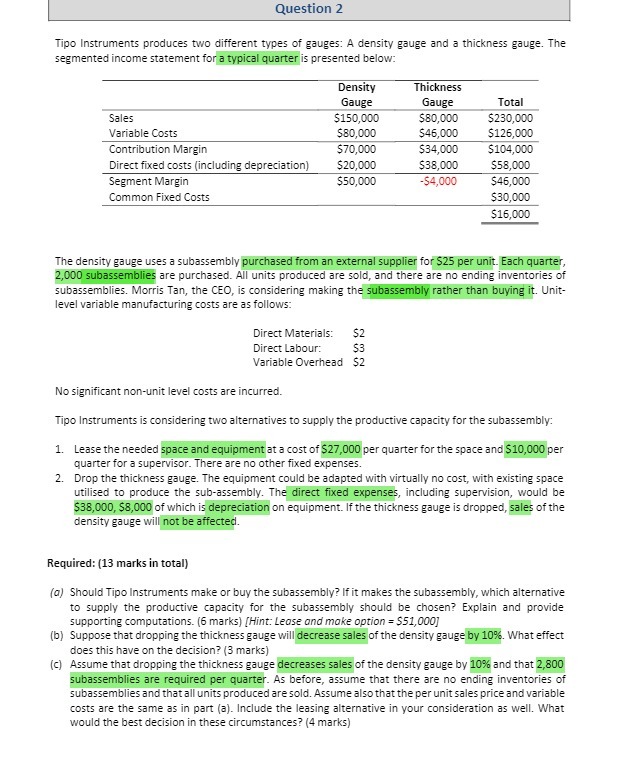Question 2 Tipo Instruments produces two different types of gauges: A density gauge and a thickness gauge. The segmented income statement for a typical quarter is presented below: Density Thickness Gauge Gauge Total Sales $150,000 $80,000 5230,000 Variable Costs $80,000 $46,000 $126,000 Contribution Margin $70,000 $34,000 $104,000 Direct fixed costs (including depreciation) $20,000 $38,000 $58,000 Segment Margin $50,000 54,000 $46,000 Common Fixed Costs $30,000 $16,000 The density gauge uses a subassembly purchased from an external supplier for $25 per unit. Each quarter, 2,000 subassemblies are purchased. All units produced are sold, and there are no ending inventories of subassemblies. Morris Tan, the CEO, is considering making the subassembly rather than buying it. Unit- level variable manufacturing costs are as follows: Direct Materials: $2 Direct Labour: $3 Variable Overhead $2 No significant non-unit level costs are incurred. Tipo Instruments is considering two alternatives to supply the productive capacity for the subassembly: 1. Lease the needed space and equipment at a cost of $27,000 per quarter for the space and $10,000 per quarter for a supervisor. There are no other fixed expenses. 2. Drop the thickness gauge. The equipment could be adapted with virtually no cost, with existing space utilised to produce the sub-assembly. The direct fixed expenses, including supervision, would be $38,000, $8,000 of which is depreciation on equipment. If the thickness gauge is dropped, sales of the density gauge will not be affected. Required: (13 marks in total) (a) Should Tipo Instruments make or buy the subassembly? If it makes the subassembly, which alternative to supply the productive capacity for the subassembly should be chosen? Explain and provide supporting computations. (6 marks) [Hint: Lease and make option = $51,000] (b) Suppose that dropping the thickness gauge will decrease sales of the density gauge by 10%. What effect does this have on the decision? (3 marks) (c) Assume that dropping the thickness gauge decreases sales of the density gauge by 10% and that 2,800 subassemblies are required per quarter. As before, assume that there are no ending inventories of subassemblies and that all units produced are sold. Assume also that the per unit sales price and variable costs are the same as in part (a). Include the leasing alternative in your consideration as well. What would the best decision in these circumstances? (4 marks)







